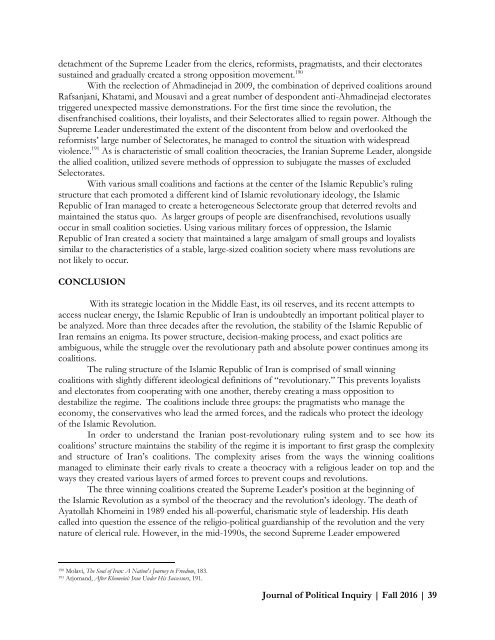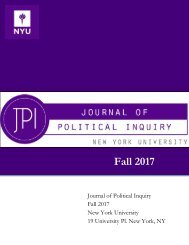Fall2016_Final
You also want an ePaper? Increase the reach of your titles
YUMPU automatically turns print PDFs into web optimized ePapers that Google loves.
detachment of the Supreme Leader from the clerics, reformists, pragmatists, and their electorates<br />
sustained and gradually created a strong opposition movement. 190<br />
With the reelection of Ahmadinejad in 2009, the combination of deprived coalitions around<br />
Rafsanjani, Khatami, and Mousavi and a great number of despondent anti-Ahmadinejad electorates<br />
triggered unexpected massive demonstrations. For the first time since the revolution, the<br />
disenfranchised coalitions, their loyalists, and their Selectorates allied to regain power. Although the<br />
Supreme Leader underestimated the extent of the discontent from below and overlooked the<br />
reformists’ large number of Selectorates, he managed to control the situation with widespread<br />
violence. 191 As is characteristic of small coalition theocracies, the Iranian Supreme Leader, alongside<br />
the allied coalition, utilized severe methods of oppression to subjugate the masses of excluded<br />
Selectorates.<br />
With various small coalitions and factions at the center of the Islamic Republic’s ruling<br />
structure that each promoted a different kind of Islamic revolutionary ideology, the Islamic<br />
Republic of Iran managed to create a heterogeneous Selectorate group that deterred revolts and<br />
maintained the status quo. As larger groups of people are disenfranchised, revolutions usually<br />
occur in small coalition societies. Using various military forces of oppression, the Islamic<br />
Republic of Iran created a society that maintained a large amalgam of small groups and loyalists<br />
similar to the characteristics of a stable, large-sized coalition society where mass revolutions are<br />
not likely to occur.<br />
CONCLUSION<br />
With its strategic location in the Middle East, its oil reserves, and its recent attempts to<br />
access nuclear energy, the Islamic Republic of Iran is undoubtedly an important political player to<br />
be analyzed. More than three decades after the revolution, the stability of the Islamic Republic of<br />
Iran remains an enigma. Its power structure, decision-making process, and exact politics are<br />
ambiguous, while the struggle over the revolutionary path and absolute power continues among its<br />
coalitions.<br />
The ruling structure of the Islamic Republic of Iran is comprised of small winning<br />
coalitions with slightly different ideological definitions of “revolutionary.” This prevents loyalists<br />
and electorates from cooperating with one another, thereby creating a mass opposition to<br />
destabilize the regime. The coalitions include three groups: the pragmatists who manage the<br />
economy, the conservatives who lead the armed forces, and the radicals who protect the ideology<br />
of the Islamic Revolution.<br />
In order to understand the Iranian post-revolutionary ruling system and to see how its<br />
coalitions’ structure maintains the stability of the regime it is important to first grasp the complexity<br />
and structure of Iran’s coalitions. The complexity arises from the ways the winning coalitions<br />
managed to eliminate their early rivals to create a theocracy with a religious leader on top and the<br />
ways they created various layers of armed forces to prevent coups and revolutions.<br />
The three winning coalitions created the Supreme Leader’s position at the beginning of<br />
the Islamic Revolution as a symbol of the theocracy and the revolution’s ideology. The death of<br />
Ayatollah Khomeini in 1989 ended his all-powerful, charismatic style of leadership. His death<br />
called into question the essence of the religio-political guardianship of the revolution and the very<br />
nature of clerical rule. However, in the mid-1990s, the second Supreme Leader empowered<br />
190<br />
Molavi, The Soul of Iran: A Nation's Journey to Freedom, 183.<br />
191<br />
Arjomand, After Khomeini: Iran Under His Successors, 191.<br />
Journal of Political Inquiry | Fall 2016 | 39
















